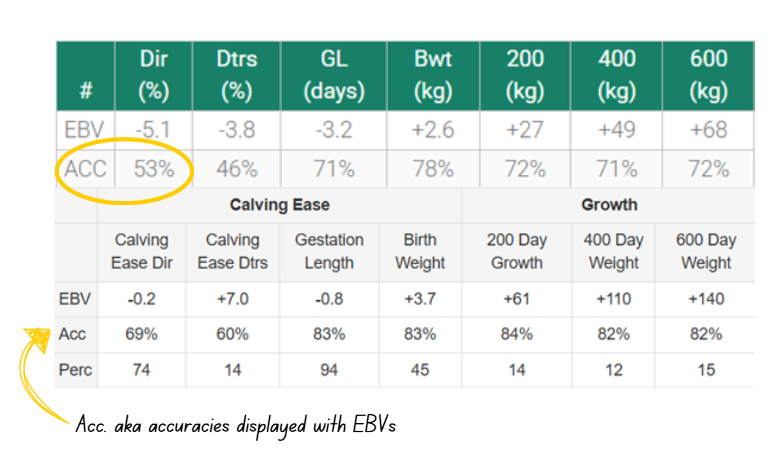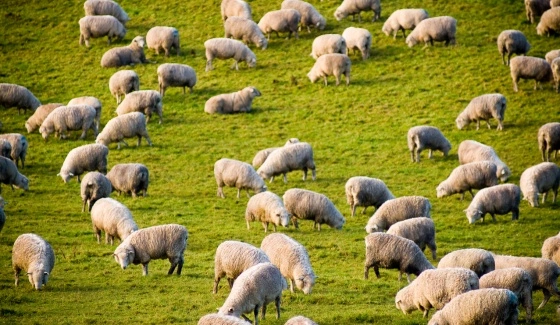
When I hear the word accuracy, I immediately think of sport. Netball, AFL, cricket - they’re all games where hitting your target matters. Whether it's Ash Barty landing a precision backhand or Buddy Franklin slotting a goal from the boundary, the greats aren’t just talented, they’re consistent. They deliver under pressure, time and time again.
Livestock breeding is no different. Accuracy in breeding values tells us how confident we can be that an animal will pass on the traits we are selecting for. Just like in sport, success doesn’t come from one-off brilliance. It comes from repeatable, reliable performance and in breeding, that’s built on good data.
What is accuracy, and why does it matter?
In livestock genetics, accuracy is a number between 0 and 99 expressed as a percentage that reflects how close a breeding value is likely to be to the animal’s true genetic merit. The higher the accuracy, the more reliable that number is. It gives producers confidence that what they see on paper will hold up in the paddock.
High accuracy means the breeding value has been calculated using strong data and is unlikely to change much. A low accuracy value is more likely to shift as more information becomes available. It’s the difference between putting your faith in a young batsman without the runs on the board versus selecting a veteran with a proven record.
For commercial producers, this matters. Breeding decisions are long-term investments, and accuracy helps manage risk. It allows producers to identify which animals are worth backing now and which ones still need to prove themselves.

When is a breeding value’s accuracy high enough?
Like watching a young gun get more game time, breeding values become more reliable over time as more information is added to the evaluation.
Here’s a guide to understanding breeding value accuracy:
- Less than 50% – Low accuracy. Likely based on limited pedigree or performance data. These values can change significantly.
- 50–74% – Medium accuracy. Usually includes own performance and some pedigree depth. Still some risk of change.
- 75–90% – Medium-high accuracy. Often includes own performance and early progeny data. Becoming more stable.
- Over 90% – High accuracy. Supported by significant progeny information. These values are unlikely to shift much.
Here’s an example. Let's think about a bull's fertility breeding value. When purchased as a yearling, he will have no daughters calving yet. His ‘Days to Calving’ EBV is likely to be based purely on pedigree and perhaps some DNA data. It is not until those daughters mature and start calving that his true fertility performance becomes clear. Over time, as more records come in, the accuracy improves and the value becomes more reliable.
What influences accuracy?
There are several factors that affect the accuracy of the breeding values presented to us at any given time:
- More data: Just as an athlete trains to sharpen their accuracy, breeding value accuracy improves as more data is collected. Pedigree provides a starting point, but on its own, it offers limited confidence. Adding the animal’s own performance, such as weaning weights, scan results, or structural scores, helps build a clearer picture. The biggest lift comes when progeny data enters the equation. If a bull consistently sires heavy calves or fertile daughters, it gives us far greater confidence that the associated breeding values reflect his true genetic potential.
- DNA: Genomic testing also plays a key role, especially for young animals. By using DNA information, we can make earlier and more reliable predictions, even before progeny hit the ground. This is especially useful for traits that are hard to measure or appear later in life, like intramuscular fat (IMF) or female fertility.
- Linkage: Another factor in accuracy is linkage: animals that are genetically connected to others in the evaluation. For example, using semen from popular artificial insemination sires helps to improve comparisons, strengthens the genetic evaluation and lifts accuracy.
- Heritability: Traits like growth tend to have higher heritability, so genetic differences are easier to detect, and breeding values tend to be more accurate. Traits like fertility are lower in heritability, which means environmental factors have more influence, and accuracy builds more slowly. (See figure 2.)

Breeding values with low accuracy still have value
Some producers avoid low-accuracy breeding values altogether, but this might mean missing good opportunities. In a recent podcast interview, Dr Kirsty Moore referred to research where she explored this through a ‘knock-out’ study. The team temporarily removed 10 years of data and grouped animals based on early, low-accuracy fertility EBVs. They then reinstated the full 10 years of data to see whether those early groupings held up. On average, they did. While some animals shifted categories, the broad patterns remained the same.
This showed that, while low-accuracy breeding values may change, they still provide useful guidance. In many cases, animals identified as high or low performers early on maintained that trend when more data became available. A low-accuracy EBV is better than having no EBV at all. You just need to be aware that it carries more uncertainty.
So, how much emphasis should a breeder place on accuracy? Moore mentioned it depends on your goals and your personal appetite for risk. Breeding values with lower accuracy are more likely to change, which means there’s more uncertainty. For some operations, particularly those making long-term female selection decisions, that extra risk may not be acceptable. For others chasing fast terminal gain, it might be worth taking the punt on potential.
It’s also important to remember that the complex math behind breeding value calculations already accounts for uncertainty. When limited information is available, the system naturally regresses the breeding value towards the breed average. This built-in safeguard ensures that extreme values without strong data support are moderated. So while low-accuracy EBVs may still carry more risk, the system is designed to help producers avoid overconfidence in incomplete predictions.
Strategies to improve breeding value accuracy
Building accuracy is about collecting quality data over time. Recording birth dates, weights, calving ease scores, ultrasound scan results, and structural scores consistently is key. The more information you feed into the evaluation, the more reliable your breeding values become.
Using genomic testing can fast-track accuracy, especially for young animals. This is particularly valuable for traits that don’t show up until later in life. Another way to improve accuracy is to use well-proven sires with good linkage into national evaluations. This connects your animals into the broader genetic picture and improves comparisons.
Being involved in across-herd/across-flock evaluations like BREEDPLAN or Sheep Genetics also helps, as does participating in benchmarking initiatives such as the Angus Sire Benchmarking Program or a central progeny test (CPT). These programs bring more data into the system and improve accuracy for the breed as a whole.
Common misunderstandings
There are a few common myths around accuracy. One is assuming that a high breeding value is always the best pick, even if the accuracy is low. In reality, a flashy number without reliable backing could change. It is smarter to balance the value itself with how confident we are in it.
Another is thinking that looks or phenotype can replace breeding values. A big, well-fed bull might look impressive in the paddock, but that doesn’t mean he has the genetics to match. Appearance is shaped by feeding and environment, and doesn’t always tell the full story.
There is also a belief that genomics alone guarantees high accuracy. Genomics is powerful, but it works best when combined with other data such as performance records, progeny results and linkage. No single source of information is enough on its own.
Wrapping up
Accuracy is more than just a number on a report. It is the confidence behind your decisions. Like a star player who consistently performs when it counts, high-accuracy animals give you peace of mind. They reduce risk and help ensure that the traits you are selecting for actually show up in the next generation.
By understanding what accuracy means, what affects it and how to improve it, producers can take the guesswork out of breeding. It’s not about chasing the biggest numbers; it’s about backing animals with the data to prove they’ll deliver. In sport, the scoreboard never lies, and with accuracy on your side, you can hit the mark more often than not.
A shout-out to Jane Worner for the article inspiration. Let me know if there’s a topic you want me to delve into next!
More information on breeding value accuracy
Understanding EBV Accuracy - BREEDPLAN
Maximising Livestock Potential using Breeding Values with Dr Kirsty Moore - Genetics in the Paddock with Emily, Season 1, Episode 5 (published December 3, 2023).
________
Join the conversation on The Hub
Take a moment to head over to the neXtgen Agri Hub to share your thoughts and questions about breeding value accuracy.



.jpg)

.webp)



